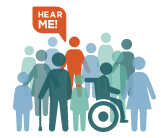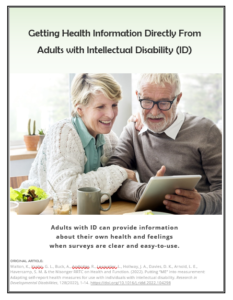On October 28th, 2022, the OSU Nisonger RRTC held their 5th Annual Summit Meeting.

OSU RRTC project leaders and staff met with members of the REEP (Research Experience Expert Panel) and the DEEP (Disability Experience Expert Panel) to:
- Review outcomes and lessons learned from the last four years of our project
- Discuss the status of our research studies
- Kick-off the 5th year of our project
Meeting materials, including the agenda, handouts, and videos are below:
- Click on links & images below to download files or go to websites.
- Watch the videos at the bottom of the page to learn more about Year 4 project activities and
lessons learned across project years (2018-2022).
Meeting Location
(In-Person) Meeting was held in Graves Hall on OSU Medical Center Campus
- Graves Hall
- 333 W 10th Avenue Columbus, OH 43210
- Rooms 1059, 1063, 1069

- Visitors may park at the OSU Safe Auto Visitors Garage
- 1585 Westpark Street, Columbus, OH 43210
- Garage located next to Panera Bread
(Virtual) Meeting was also streamed on Zoom
Meeting Materials
Agenda

Ice Breaker Activity
Witches’ Brew
Every witch must add one ingredient to the magic potion recipe before time runs out!

Rules:
1. Ingredients must be given in alphabetical order (A-Z) & must include a specific amount;
for example:
-
- Ants, 3 cups
- Toadstools, 5 fresh caps
2. Only one ingredient per person – with group support, as needed
3. Ingredients may come from animals, plants, or fungi, it may be fresh or dried, whole or diced, organic or inorganic, normal & natural, or super spooky & supernatural
“Eye of newt, and toe of frog,
Wool of bat, and tongue of dog,
Adder’s fork, and blind-worm’s sting,
Lizard’s leg, and owlet’s wing,—
For a charm of powerful trouble,
Like a hell-broth boil and bubble.
Double, double toil and trouble;
Fire burn, and caldron bubble.”
-Shakespeare, MacBeth (IV, I, 14-15)
What Have We Learned Across Project Years?
Summary and Q&A
- Project Studies and Partnerships
- Study 1
- Study 2
- Study 3
- Knowledge Translation (KT)
- Research Experience Expert Panel (REEP)
- Disability Experience Expert Panel (DEEP)
- Project Accomplishments, Publications, Themes, and Lessons Learned
Clear Language Presentation
Paper 3 Article
Paper 3 Clear Language Product
Getting health information directly from
adults with intellectual disability (ID)
Breakout Groups
(Pick One Group Below that You Want to Join at the Meeting)
GROUP 1
Research about us, with us:
Why is it important to engage partners with disabilities in research projects?
ABOUT
In this group, we will talk about how to engage partners with disabilities in research.
Our discussion will be driven by our research project’s experience partnering with members of the Disability Experience Expert Panel (DEEP).
We will:
- review the role of DEEP members in our project
- discuss what DEEP members have done for the project to date
- ask DEEP members how they feel about their role and work on the project
- talk about other research topics that interest DEEP members
- think about where we can go next in research together
QUESTIONS
- What knowledge, skills, or abilities did you bring to the research project?
- How has your knowledge, skills, or abilities changed since joining the DEEP?
- What parts of DEEP membership have been easy for you?
- What parts of DEEP membership have been hard for you?
- What have you enjoyed about being a member of the DEEP?
- What has been your favorite activity working on this project?
- What has been the biggest lesson you learned working on this project?
- What supports or accommodations have helped you participate as partners in the project?
- Did the meetings & activities include your voice and make you feel empowered as a partner?
- How has your work helped the research project?
- What health- or disability-related questions do you want answered by research?
- How could future research projects better engage you as a partner in the process?
MATERIALS
- OSU Nisonger RRTC clear language products
- Co-research with adults with intellectual disability: A systematic review (Di Lorito et al., 2017)
GROUP 2
Calculating the percentage of adults with intellectual disability who also have a psychiatric disorder
ABOUT
According to analyses of current DIAAID data from our Prevalence Study sample, as of October 7th,
we have the following rates of comorbidity of psychiatric disorders
[percent of adults with intellectual disability reported to have a mental health disability]:
- Self-reported DIAAID: 31% (based on 109 interviews with adults with ID)
- Proxy reported DIAAID: 58% (based on 121 interviews with study partners)
This discussion is about developing an approach to treating data from the DIAAID obtained from
Adults with Intellectual Disability (ID) and Study Partners in calculating the prevalence rate of co-occurring psychiatric disorders in adults with ID.
In other words, we will talk about how to reconcile self-reported DIAAID/psychiatric symptoms with proxy reported DIAAID/psychiatric symptoms.
Reconciling is a process of deciding what to do with information from different sources to come to a final decision.
QUESTIONS
We have a few questions to help start this discussion:
- How should we approach determining “caseness”?
- How should we approach determining “caseness, when the self-reported DIAAID/psychiatric symptoms and proxy reported DIAAID/psychiatric symptoms do not align?
- Are there situations/disorders that warrant that we prioritize self-reported DIAAID information/psychiatric symptoms over proxy reported DIAAID information/psychiatric symptoms?
- Are there situations/disorders that warrant that we prioritize proxy reported DIAAID information/psychiatric symptoms over self-reported DIAAID information/psychiatric symptoms?
- According to our analyses on DIAAID data collected on our Prevalence Study sample as of October 7th (N=121), we have the following rates of ADHD comorbidity:
- Self-reported DIAAID: Not included in the interview
- Proxy reported DIAAID: 45% (n=54/120) [*All cases of ADHD were of “inattention” type]
Does this prevalence rate of comorbid ADHD in adults with ID appear consistent with your experience and/or knowledge of published studies reporting on rates of comorbid psychiatric disorders in persons with ID?
If not, and if these rates were to maintain themselves with the full Prevalence Study sample, what should we examine?
MATERIALS
- Prevalence Study Demographics Report as of 10/07/2022
- Buckles et al. (2013) – review of prevalence studies of ID and psychiatric disorders
- Cooper et al. (2022) – chapter on comorbid ID and psychiatric disorders
- Cooper et al. (2007) – mental ill health in adults with intellectual disabilities – prevalence and associated factors
- Platt et al. (2019) – intellectual disability and mental disorders in a US population representative sample of adolescents
GROUP 3
Reviewing Treatment Guidelines
ABOUT
In this group, we will review a draft of the proposed treatment guidelines (see materials below).
The guidelines we propose are based on a literature review, focus groups, and stakeholder feedback.
- The audience of this draft is clinicians
- The goal is to avoid overly formal language, but it may not be fully clear language
- In the future, we will work with DEEP to make a clear language version for adults with ID and their families
QUESTIONS
- In each section, is the tone and message appropriate?
- Are we missing any topics within existing sections?
- Are we missing any key concepts?
- Are there resources or examples that you think would be helpful to include?
MATERIALS
Where Do We Go from Here?
Think & Talk
Questions to guide a discussion about our next steps…
- What research questions do we want answered?
- What ideas do we have for future research studies?
- How should we keep people with ID engaged in research?
- To whom should we look for funding?
- What can we do without funding?
Study 1: Measure Adaptations
Making health surveys better
for adults with intellectual disability (ID)
Study 2: Prevalence Estimates
Finding out how many adults with ID
across the nation have mental health needs
Study 3: Clinical Guidelines
Learning the best ways to serve adults with ID
who have mental health needs
Knowledge Translation (KT)
Sharing our work through articles, presentations, and clear language products
Disability Experience Expert Panel (DEEP)
A group of research partners with lived disability experience who advise our project


